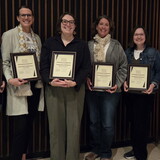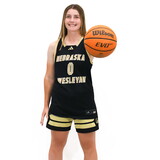Nebraska Wesleyan Art Director Melanie Reinmiller was recently recognized as volunteer of the year at the Lincoln Homeless Coalition's 22nd Annual Hunger and Homelessness Recognition Event. The event aims to recognize the extraordinary efforts made by community members on behalf of individuals experiencing poverty, homelessness and hunger.
Melanie and her family have been making and stocking community pantries since 2019. The first pantry was installed at their first house just after Christmas in 2019. Since then, the Reinmillers and fellow community members have helped to install nearly 40 pantries across the city. The project is titled "Little Free Pantry" and helps to serve anyone in need within our community.
We recently spoke with Melanie to learn more about her efforts to combat hunger and homelessness in our community, here is what she had to say:
What is your connection to serving the hungry and homeless in our community?
Helping folks experiencing homelessness is a passion of my husband, Michael. He brought the issue to my attention and slowly but surely I ended up involved in everything he was doing – putting my own talents to use. It’s such a simple act of empathy to imagine what someone else is going through – it’s hard not to want to help. It’s been surprising learning how different folks ended up in a tight spot. We are all closer to homelessness than we know. I once read a statistic that talked about how most of us are just a handful of paychecks away from being homeless. Things can just snowball.
My connection is also based off of personal experiences of interacting with those facing homelessness or food shortages. I serve monthly meals with our church (Unitarian Church of Lincoln), I’ve had discussions with women at Fresh Start, and I've heard from friends and acquaintances who have visited a food bank when they couldn’t manage on their own.
"The pandemic takes away the face to face part of our efforts, and that is something we've missed."
How did you get the idea to install community pantries?
We saw a program where a pantry was installed in another town and a lady was interviewed using the pantry. She talked about how it was great to have a resource so close to where she lived and that was open 24/7. I didn’t think about how many food pantries are only open certain times or might require paperwork. If you’re someone on the edge of requirements who works 3rd shift—the pantries might be your only option. It’s filling a crack in the system.
Who makes the pantries?
Michael talked with my very handy father, Jim Falk, and first got him making pantries. But really, the pantries have been made by all kinds of folks. My dad made about 13 of them throughout Lincoln. He took a look at some patterns he found online and adjusted them to fit our climate, the specific location and the items commonly stocked. He’s even made a couple from former Lincoln Journal Star newspaper stands. We were able to get a grant from Civic Nebraska for a few of the pantries, but others were self-funded. My dad has given so much free labor and time to this project but like us, it's the kind of thing we love to do – plus it helps people. Win, win.
How are the pantries maintained?
Pantries are maintained by the property hosts. My dad has gone around to help on occasion, and one of the pantry hosts is also a handy-woman. Hosts will also put a call-out to friends and neighbors looking for help. It continues to be a grass-roots effort. There’s no lump of cash that we’re pulling from to collectively maintain and create new locations.
As far as filling the pantries with supplies – it’s on the community. The hosts take on a majority of the responsibility. We do have a Facebook group and try to get regular food drives going. It’s the neighbors, friends and community members that ultimately keep them filled. They all need help keeping stocked. Many of the pantries in lower income areas are bare more than they are filled. There is so much need and it’s only gotten worse with the pandemic.
Is there an end goal to the pantries?
The end goal of the pantries is to get folks fed and taken care of. This is just one piece of the puzzle to help folks get back to a place where they can sustain themselves. Right now the pantries are not a true non-profit. It’s all grass-roots effort with different levels of commitment and communication, but the common goal is to help.
What does it mean to have your son involved?
It’s been so important that our son see how important it is to help people - to have empathy and understand what it is to be human. We are all worthy of having our needs met. Both Michael and I have parents who were involved and volunteered in their communities so it's an important legacy to us.
How can people get involved?
The best way to get involved is by simply checking on your neighbors and friends—make sure they are ok. Beyond that, here are some ways to help out:
- Sign up to deliver meals for Meals on Wheels or donate to Meals on Wheels
- Take used women’s clothing to Fresh Start, attend an open house or benefit event, and volunteer or donate to Frest Start
- Take certain dry goods or hygiene products to your neighborhood pantry regularly. Locations of pantries can be found on the About tab on their Facebook page
- Donation ideas include: dry goods, such as pasta, rice, box meals; bread, cereal and granola bars; peanut butter and jelly; tea and coffee; shelf stable produce*; protein products, such as canned* meats, fish and beans; cooking items, such as oil, sugar, flour and spices; hygiene items, such as deodorant, shampoo and feminine hygiene products; and cleaning items, such as dishwashing detergent and laundry detergent.
- You can also donate funds to many of your local pantries, including:
*NOTE: please be mindful of climate—cans/jars may burst when temps reach freezing temperatures.
Nebraska Wesleyan congratulates Melanie for this recognition and thanks her for her commitment to the university and the Lincoln community.

















